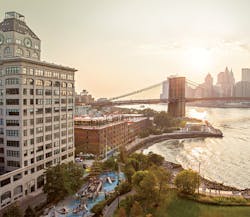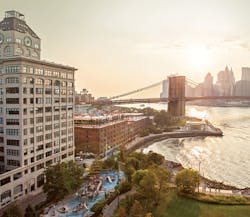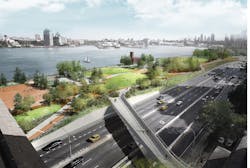The Case for Resiliency in Municipal Water
New York’s Green-Blueprint shows how resiliency will take utilities into the future
By William Steel
Attention to water infrastructure is a prominent feature of OneNYC, a comprehensive strategy for the city’s development. Image courtesy NYC & Company/Tagger Yancey IV.
New York’s water sector finds itself in an exciting state of transition. Aging infrastructure is being revitalized and expanded in alignment with the city’s growth, while water asset stakeholders are engaging with outside sectors to deliver more holistic solutions, better integrated within the city. The result: water system development not only tuned for the challenges of today’s New York but safeguarded against uncertainties of the future.
In New York, maintaining municipal water assets has gained added significance in recent years with the high ambitions set forth by OneNYC — a comprehensive, multi-faceted strategy for the city’s development. Here, attention to water infrastructure is a prominent feature, identified within several of the strategy’s visions and subordinate initiatives.
These plans — perhaps most notably a net-zero energy target for the city’s 14 wastewater treatment plants by 2050 — position New York as a national leader in water solutions. Catalyzing evolution in New York’s water scene, the various goals are driving stakeholders to explore novel technologies for more efficient, sustainable water treatment and supply.
The net-zero goal, for instance, has led NYC’s Department of Environmental Protection (DEP) to develop energy conservation measures across all 14 of the city’s WWTPs, including evaluation of opportunities for solar photovoltaic (PV) installations.
By the end of December 2017, construction had begun on a 12 MW cogeneration system at the North River Wastewater Treatment Plant. And at the Newtown Creek Wastewater Treatment Plant, waste-to-energy technology has been deployed as part of a codigestion demonstration project ramping up to process 250 tons food waste per day by June 2019, from 60 tons per day achieved in 2017.
“DEP is simultaneously meeting the ambitious OneNYC energy reduction goals and new energy-intensive water/wastewater quality regulatory mandates, while integrating and not sacrificing state-of-good-repair needs,” said Tara Deighan, DEP deputy press secretary, describing the utility provider as “becoming a progressive leader in sustainable operations and resource recovery, seeking the best investments for environmental and social solutions.”
There’s a “robust capital program” financing the aspirations too: N.Y. Governor Andrew Cuomo has made funding of blue infrastructure a priority, with $2.5 billion pledged for 2017-2018 alone.
Still, there is another aspect to the evolution of New York’s water scene, one characterized less by state-of-the-art technology and more by its approach to planning water assets.
Arcadis, a leading engineering firm heavily involved in NYC’s urban development scene, is contributing in no small part to this. “With changing climates, the new normal can be pretty extreme, and with the associated risks urban spaces must be designed to address these circumstances in a proactive, rather than reactive, manner,” said Edgar Westerhof, flood risk and resilience lead at Arcadis.
“Resiliency is about developing assets with an eye towards the future and recognizing how multiple urban systems are connected. It involves raising the bar wherever possible and assuring we’re building for this new normal while safeguarding asset functions of the past.”
A textbook example of Arcadis’s application of this systems-based mindset is evidenced in its development of the Big U and Waterfront Resiliency Plan of Manhattan, which after much anticipation is slated to break ground on an initial 2.5-mile stretch of sea level defense around lower Manhattan later this year.
Alongside private actors embracing the new ways, so too are public bodies. DEP’s Office of Integrated Water Management is taking an active role in responding to these new circumstances. Leading the office is Alan Cohn, who told WaterWorld: “Resilience involves optimizing the system to absorb shocks more readily. Anything we can do to reduce demand on the system whilst optimizing our resources makes us more resilient to otherwise harmful events.”
Cohn explained that the office’s twofold focus prioritizes demand management (including water conservation) and climate resiliency: “We see the two as very much intertwined, as demand management is a central tool in our climate resilience toolbox when it comes to drinking water supply and sewage.”
Since New York operates a majority combined sewer system, water asset resiliency hinges upon recognition of relationships between combined sewer overflow, stormwater management and water quality.
A prime example of the value of this mindset in action presents itself in the increasingly critical context of tackling New York’s susceptibility to extreme rainfall, or ‘cloudburst’ events. Such events can overwhelm sewers and associated infrastructure, and create localized flooding. With the potential consequences as severe as they are, the circumstances prompted the DEP’s Cloudburst Resiliency Planning Study to assess risks and management strategies, and develop new solutions.
“With Cloudburst we recognized we cannot just upgrade infrastructure and build bigger pipes. Even if we did, there would always be a larger storm above the design standard,” said Cohn.
He continued: “The new perspective is that this isn’t a DEP problem but an issue we need to collectively understand and solve as a city. City agencies with property, streets or parks, need to ask how we can use groundwater management to address flooding and reduce discharge from sewers to harbor.”
Inspired by a program of cloudburst mitigation undertaken in Copenhagen, Denmark — and working with the city under a three-year MoU on cloudburst management that commenced in 2015 — DEP is applying a resiliency lens to address the threat.
Although not at the same scale as in Copenhagen, DEP has multiple cloudburst pilot projects underway. Here, in place of traditional engineering measures to manage stormwater runoff, investment is made in public spaces and so-called blue-green infrastructure. Examples include permeable pavement, rain gardens, and stormwater green streets — assets that can absorb high volumes of water in order to reduce damage to and stress on traditional assets where water would otherwise go.
Remarking on Arcadis’s experiences with similar infrastructure in Pittsburgh, Westerhof said: “We’ve seen that rather than large pumps and extended sewers to prevent flooding or handle water, success is possible through large-scale green infrastructure implementation and holistic solutions.”
Within a DEP demand management program, Cohn explained that incentives for retrofitting building plumbing geared towards reducing loads on sewer system and simultaneously saving on potable water is another kind of solution in play.
These novel solutions can necessitate interagency partnering and carry challenges of their own, but they bring positive consequences across all sorts of metrics high on the city’s political, social and environmental agendas.
“Assessing water supply savings, we’ve been able to quantify reductions in flow to individual WWTPs and consequent reduction in energy consumption for treatment, both before coming through pipes from reservoirs and energy used at WWTPs for treatment. There’s a clear environmental impact,” said Cohn, highlighting that this water-energy link hasn’t always been made explicit. With the aid of Water-Energy Nexus tools developed by DEP, however, it provides a compelling account of holistic approaches.
A DEP Water-Energy Nexus study that quantified benefits associated with four of DEP’s programs during 2015 — green infrastructure, water demand management and conservation, wetland restoration and water supply forestland protection — reports:
• 687 million gallons per year (MGY) of stormwater input to NYC’s 14 WWTPs was avoided via green infrastructure;
• 528 MGY of reduced water demand and associated wastewater treatment via conserving fixtures;
• 133 MGY of reduced water demand via repairs to leaking water mains.
Associated with the programs, the study calculated an estimated reduction in total emissions for 2015 of 178,000 metric tons (MT) of CO2 (which is equivalent to removing approximately 53,000 passenger cars from the road).
Urban green spaces provide recreation areas that align with much needed passive protection of urban watersheds. Image courtesy BIG-Bjarke Ingels Group.
NY Blue Tech: A Platform for Innovation
It’s against this backdrop of a progressive water sector that NY Blue Tech has been established. A public-private partnership, NY Blue Tech was co-founded last year by the Danish Cleantech Hub in concert with DEP, NYC Economic Development Corporation, Columbia University, and the Dutch Consulate. Touted as New York State’s first interdisciplinary and international water think-tank, its ethos echoes the city’s ambitions of instilling sustainability and resiliency into its water systems.
One of the co-founders of NY Blue Tech is Klaus Lehn Christensen, project director at Danish Cleantech Hub, a public-private partnership based in NYC working to accelerate cleantech solution sharing between Denmark and New York.
“We saw a need for a forum in which public, private, and academic stakeholders could convene and collaborate around emerging technology and solutions, particularly ones relevant to wastewater and stormwater management,” Christensen said of the network’s founding.
In February 2018, NY Blue Tech hosted its first mini-conference. Examining the future of water in New York, it brought together the Commissioner of New York City’s public water utility, the Danish water-engineering consultancy DHI Group, the Regional Plan Association and Dutch ONE Architecture.
Such interdisciplinary activities — exploring the intersection of business, politics and civil society — are precisely the kind needed for the multi-sectoral resiliency approach. As Westerhof explained: “The transition we’re seeing towards collaborative planning and collaborative water management relies on people from various agencies coming together — people from public and private sectors, politics and economics, water treatment, parks, infrastructure and so on.
“But it also requires confidence from local leaders to look towards other places where solutions have been successful before. The Copenhagen MoU is a great example of creating an agenda for collaboration,” he added.
It’s a sentiment shared by NY Blue Tech and Lehn Christensen, who said: “There’s a growing recognition for the value of integrated water management in New York and consequently there’s opportunity for the city to be adopting and adapting European models where these practices have matured somewhat already.”
To facilitate this, NY Blue Tech aims to support knowledge transfer of, for example, Danish water-tech solutions, channeling in proven solutions and expertise. “Introducing world-leading Danish water technology in a New York context is a great asset for the tech transfer and partnership aspirations of the NY Blue Tech network,” said Lehn Christensen.
Cohn, who has been involved in NY Blue Tech since its days on the drawing board, is enthusiastic for the platform created by the think tank, saying: “Showcasing examples from other cities and across the world where innovative solutions have been implemented is inspirational. Connecting people from multiple city agencies together, it becomes an occasion to discuss challenges, experiences and ideas when we simply wouldn’t have done so otherwise. It’s been exciting and I look forward to more to come.”
Artist rendering highlights coastal flooding initiatives featured within the BIG U project. Image courtesy BIG-Bjarke Ingels Group.
Cohn noted that whether it’s multiple agencies, departments or varied stakeholders from disparate industries, there can oftentimes be a disconnect between people seeking solutions to new and emerging problems and the groups with solutions. It’s an ubiquitous issue, but one NY Blue Tech aims to address. In particular, it’s pitched to facilitate the kind of public-private partnerships thought to lend themselves to a resiliency approach.
Describing the scale of challenges faced by water stakeholders amidst the new normal, Westerhof commented: “Solutions should and need to be a shared responsibility, with collaboration between public and private. But I’m confident [that] methodologies, tools, and financial models are evolving rapidly to include this collaborative thinking and planning.”
While cities throughout the U.S. are beginning to adopt systems-based resiliency approaches, it seems New York is getting ahead of the curve.
“We all agree that we’re facing challenges of our lifetimes when it comes to protecting a city like New York. But we’re seeing the city adopting new approaches and implementing things in an impressive way,” said Westerhof. “It’s not just talk, and a lot has been accomplished in the last five years. New York is definitely leading the charge.” WW
About the Author: William Steel is a freelance reporter covering renewable energy, water and cleantech industries.



